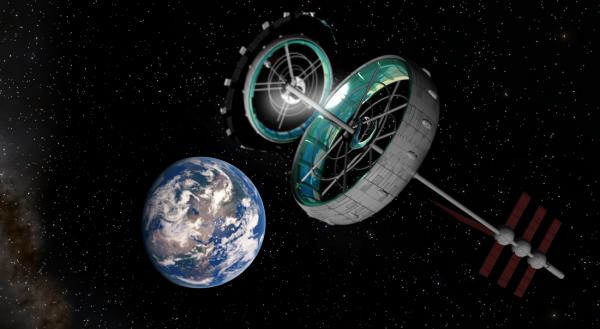BY LETTER
Stanford Torus
 Image from Steve Bowers | |
| Harlem High, a Stanford Torus orbiting old Earth | |
A very simple form of continuous ring-shaped habitat is the torus; the classic design shown is the so-called Stanford Torus, which uses mirrors to illuminate the internal surface through a transparent roof.
The original proposal for this type of colony was made in the Information age at Stanford University in the USA. The design called for a torus one 'mile' (1.6 kilometers) in diameter housing 10,000 people.
In the image at the bottom, of Chih Nii habitat in orbit around Penglai, the mirror collecting the sunlight is at the top, reflecting light to a semiconical mirror in the centre of the torus. Beneath the torus in the image is a radiator fin (introduced to cool the habitat because of the excess of collected sunlight), and two photoelectric arrays (of course the entire structure is in zero-gee except for the rotating torus itself, so has no real 'top' or 'bottom').
This image shows the interior of a Stanford Torus. The transparent roof can be easily seen. In the original design the population density was intended to be similar to a suburban area of Earth, with mixed residential, recreational and agricultural areas. However in practice most Stanford Tori are not as densely populated, with many examples dedicated to recreational use or specialised agriculture.
More elaborate arrays of mirrors can be used to collect sunlight if the habitat is far from the local star. Many other toroidal and ring shaped habitats do not have transparent sections and use artificial lighting throughout; these are generally more densely populated than true Stanford tori.
Image from Steve Bowers | |
| Chi Ni habitat, a Stanford Torus orbiting Penglai | |
Related Articles
- Banks' Orbital
- Bernal Sphere
- Bishop Ring
- McKendree Cylinder
- O'Neill Cylinder
- Orbital (habitat)
- Orbital (political unit) - Text by M. Alan Kazlev
Originally, a nation state or city state based on habitats in orbit around Old Earth. Over the course of the Interplanetary Age the term came to be used for any such state in Solsys. By early First Federation times the term Orbital was used more broadly for any independent or semi-independent state based on a hab in orbit around a planet. - Rotating Space Habitats
Appears in Topics
Development Notes
Text by Steve Bowers
Initially published on 27 August 2008.
Initially published on 27 August 2008.






